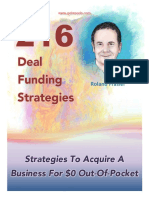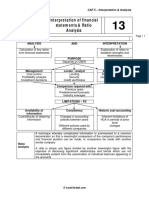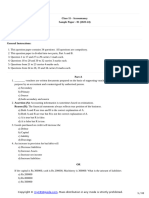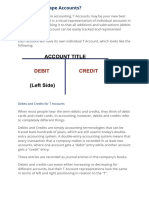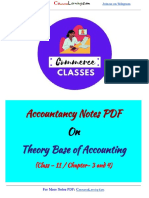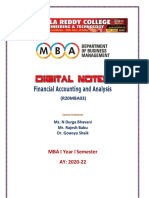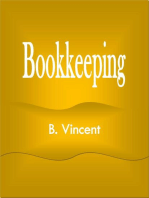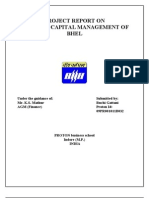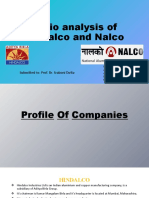Important Questions For CBSE Class 11 Accountancy Chapter 1 - Introduction To Accounting
Important Questions For CBSE Class 11 Accountancy Chapter 1 - Introduction To Accounting
Uploaded by
DHRUV SARVAIYA 9320Copyright:
Available Formats
Important Questions For CBSE Class 11 Accountancy Chapter 1 - Introduction To Accounting
Important Questions For CBSE Class 11 Accountancy Chapter 1 - Introduction To Accounting
Uploaded by
DHRUV SARVAIYA 9320Original Description:
Original Title
Copyright
Available Formats
Share this document
Did you find this document useful?
Is this content inappropriate?
Copyright:
Available Formats
Important Questions For CBSE Class 11 Accountancy Chapter 1 - Introduction To Accounting
Important Questions For CBSE Class 11 Accountancy Chapter 1 - Introduction To Accounting
Uploaded by
DHRUV SARVAIYA 9320Copyright:
Available Formats
Important Questions for Class 11
Accountancy
Chapter 1 – Introduction to Accounting
Very Short Answer Questions 1 Mark
1. What do you understand by “Accounting”?
Ans: Accounting is the progression of recording financial transactions affecting a
business. The summary of financial transactions for a particular accounting period,
summarizing a company's data, financial position and cash flows by preparing
financial statements is also known as accounting.
2. What is the change in the role of an accountant?
Ans: Now accountants not only record transactions but also provide required
information to members. This will create new opportunities for the accountants to
get indulged in other scope of business management.
3. What do you mean by Asset and liabilities?
Ans: Assets are the items owned by an individual or a company that can provide
future economic benefit. Liabilities are what you owe to the other parties.
4. Define capital of the company.
Ans: Capital of the company is the mix of assets or resources a company can draw
on in financing its business.
5. Define debtors and creditors of the company.
Class XI Accountancy www.vedantu.com 1
Ans: Creditors are those people or firms to whom money is payable or extend credit
to another party during the course of business. Debtors are those people or firms to
whom money is receivable. Debtors are bound to pay the money due to them during
the course of business.
Short Answer Questions 2 Marks
1. To whom and for what process the accountant provides information?
Ans: Accountant of the company provides information to members of the company
and shareholders, creditors, vendors, financial analysts, and government agencies
for the decision making process, which helps management for fast and correct
decision implementation.
2. Describe four nature of accounting
Ans: Accounting nature can be classified in following ways;
a) Accounting is an information system.
b) Accounting relates with financial information and transactions.
c) Accounting is mean and not an end.
d) Accounting is an art
e) Accounting is a process
3. Differentiate between Capital and working capital?
Ans: The difference between capital and working capital are:
Capital Working capital
The capital is the assets and cash in Working Capital specifies the
a business. liquidity levels of companies for
handling day-to-day expenses.
Class XI Accountancy www.vedantu.com 2
Capital can be Assets, Cash and cash equivalents consists
Equipments, Cash, Land and of cash, such as amount in
Buildings. etc. checking or savings accounts, as
cash equivalents are highly-liquid
assets, such as money-market
money and Treasury bills.
4. Distinguish between Expenses and expenditure of the company?
Ans: The difference between expenses and expenditure are:
Expenses Expenditure
An expense is the cost of a An expenditure signifies a
business function that a company payment with either cash or credit
spends to generate revenue. to purchase goods or services.
In the accrual accounting system, An expenditure represents the
an expense is recognized when it is disbursement of funds.
actually spent.
Examples: Rent, wages, interest, Examples: An example of an
salaries, Cost of sales, utilities expenditure is the money spent on
expense, discount allowed, office equipment that you have
cleaning expense, depreciation purchased.
expense etc.
5. Differentiate between profit and gain?
Ans: The difference between Profit and gain are:
Profit Gain
Class XI Accountancy www.vedantu.com 3
Profit, also referred to as A gain is a general growth in the
bookkeeping profit or financial value of an asset or property.
profit, is net income made after
subtracting all dollar costs from
total revenue.
It shows the amount of money a A gain ascends if the existing price
firm has available after subtracting of something is higher than the
the explicit costs of running the original purchase price.
business.
Profit is spread to shareholders. Gain is applied in the company’s
working.
Short Answer Questions 3 Marks
1. Explain reasons why users need accounting information.
Ans: Following are the reasons why users need accounting information:
a) Owners or shareholders of the company who have invested in the company
need to know if they are getting satisfactory return for their investment.
b) Directors and managers of the company need accounting information for the
evaluation of the performance internally and externally.
c) Stockholders have the right to know how a company is handling its
investments.
d) Banks or financial lending companies can utilize the accounting data to help
in making selections such as whether to lend or how much to lend a company.
2. Define in what way accounting is the source of information.
Ans: The various ways accounting is the sources of the information are explained as
follows:
a) Helps to evaluate the flow of cash in the organization and effects due to it.
Class XI Accountancy www.vedantu.com 4
b) It is used as a means of announcement between a business organization and
its shareholders.
c) Provide information that relies on the accounting information of the
organization.
d) The accounting process is a basis of info, it uses business data and processes
it to generate applicable information.
3. What are the objectives of accounting?
Ans: The objectives of accounting are as follows:
a) The main objective of accounting is to keep an organized record of financial
transactions which helps the users to appreciate the day to day transactions in
an organized way so as to gain knowledge about total business.
b) To determine profit or loss of the business.
c) To represent the financial situation of the business.
d) To offer accounting data to the interested parties.
4. What are the different roles of accounting?
Ans: The different kind of roles of accounting are as follows;
a) Regulator of financial policy and construction of planning.
b) To preserve full and organized records of business transactions.
c) It can be used for Evaluation of employees' performance.
d) Nowadays accounting is used to determine the income of the company.
5. Explain the types of information external users of accounting information
are interested.
Ans: Following is the type of information external users need:
Class XI Accountancy www.vedantu.com 5
a) Investment created by external users including risk and reward.
b) Creditors are interested in accounting data, because it enables them to fix the
credit worthiness of the business.
c) The creditworthiness and ability of the company to pay.
d) All the information of allocations of assets of the company and compliance
are regularly carried out.
e) Amount on credit taken by the company is paid off in which aspects and time
period it takes.
Long Answer Questions 5 Marks
1. Role of accountant in today’s environment and how they help management?
Ans: Role of accountant in today’s environment can be defined as follows:
a) Accountants have various fields to work like forensic accounting, e-
commerce accounting, financial planning, etc.
b) Assisting in the direction and management of activities, such as assessing and
comparing actual performance to budget plans and directing focus to
successful or problematic areas.
c) It Helps management in the decision making process for the growth of the
company.
d) It collects the information and communicates it to the organization which
provides this information to a wide variety of stakeholders.
e) Accountants' abilities may also help the environment save money.
Environmental accountants may frequently reduce both environmental and
financial expenses by calculating the usage of alternative chemicals, methods,
or product designs.
2. Define all the four nature of accounting. Explain?
Ans: The nature of the accounting are explained below:
Class XI Accountancy www.vedantu.com 6
a) Economic Events: Economic events refer to an event which will happen for
the growth of the organization and consist of various transactions which are
in monetary terms. For example, buying an asset for the company,
transportation cost, labour cost to install the asset and other expenses in
installing such asset.
b) Identification, Measurement, Recording and Communication: First step
of accounting is to identify the nature of the transaction whether it is related
to accounting or not. Measurement means whether it can be measured in
monetary terms or not. If not then it will not be included in accounts and will
be treated differently. Recording comes after identifying and measuring the
transaction, it is then recorded in books of accounts. Communication is made
after the transaction is recorded to the relevant parties internally and
externally.
c) To depict the financial position of the business: A businessman is also
interested in establishing his financial position at the end of a given period.
For this resolution, a position statement called Balance Sheet is prepared in
which assets and liabilities are revealed.
d) Interested users of information: There are two types of users internally and
externally. Internal users of the information are directors, managers and
employees. External users are creditors, shareholders, debenture holders,
government, etc.
3. Define the branches of accounting. Explain?
Ans: The development of the economy and its complexity with technological
advancements has increased the importance of accounting and its uses. As due to
these reasons it has given rise to the new branches or ways of accounting which are
as:
a) Financial accounting: Financial accounting is the branch of accounting that
deals with the summarization, analysis, and reporting of a company's financial
activities. This entails the production of financial statements for public
consumption. Financial accounting's primary goal is to correctly create an
organization's financial accounts for a certain time, often known as financial
Class XI Accountancy www.vedantu.com 7
statements. The Profit and loss statement, balance sheet, and statement of CFOs
are the three major financial statements.
b) Cost accounting: "A structured set of methods for collecting and reporting
computation of the cost of producing things and giving services in the collection
and in detail," according to the meaning of cost accounting. Calculating fixed and
variable costs is a part of cost accounting. Fixed costs are monthly expenses that
do not change depending on the amount of output. Rent, depreciation, interest on
loans, and leasing expenditures are all examples.
c) Management accounting: The activity of finding, measuring, evaluating,
interpreting, and presenting financial information to managers in order to achieve
an organization's objectives is known as management accounting. Management
accounting enhances an organization's worth by certifying the efficiency and
effective use of limited resources, including financial resources. As a result, it
gives crucial information for employees to improve their talents.
4. Give details about the asset side of the balance sheet of the company.
Ans: Asset side of the balance sheet of the company contains:
● Non- Current Asset:
a) Fixed Asset:
i. Tangible Asset
ii. Intangible Asset
iii. Capital Work-In-Progress
iv. Intangible Assets under Development
b) Non-Current Investments
c) Deferred Tax Assets
d) Long Term Loan & Advances
e) Other Non-Current Assets
Class XI Accountancy www.vedantu.com 8
● Current asset:
a) Current investment
b) Inventories
c) Trade receivables
d) Cash and cash equivalents
e) Short term loan and advances
f) Other current asset
5. Give details about the liabilities side of the balance sheet of the company.
Ans: Liabilities side of the balance sheet of the company contains the following
details:
● Non-Current Liabilities
a) Long Terms Borrowings
b) Deferred Tax Liabilities
c) Other Long Term Liabilities
d) Long Terms Provisions
● Current Liabilities
a) Short Terms Borrowings
b) Trade Payables
c) Other Current Liabilities
d) Short Terms Provisions
Class XI Accountancy www.vedantu.com 9
You might also like
- Deal Funding Strategies: Strategies To Acquire A Business For $0 Out-Of-PocketDocument50 pagesDeal Funding Strategies: Strategies To Acquire A Business For $0 Out-Of-PocketStefan Gospodinov100% (1)
- Solving The Puzzle of The Cash Flow StatementDocument8 pagesSolving The Puzzle of The Cash Flow StatementPraneta ShuklaNo ratings yet
- 100+ Journal Entries PDFDocument5 pages100+ Journal Entries PDFsdNo ratings yet
- Notes On Subscription AccountsDocument2 pagesNotes On Subscription AccountsAbiramee Ramalingam100% (2)
- Interpretation of Financial Statements & Ratio AnalysisDocument35 pagesInterpretation of Financial Statements & Ratio Analysisamitsinghslideshare67% (3)
- CBSE Quick Revision Notes and Chapter Summary: Class-11 Accountancy Chapter 1 - Introduction To AccountingDocument6 pagesCBSE Quick Revision Notes and Chapter Summary: Class-11 Accountancy Chapter 1 - Introduction To AccountingSai Surya Stallone50% (2)
- Class XI Accountancy Importaint Questions Sample PaperDocument32 pagesClass XI Accountancy Importaint Questions Sample Papergehlotneeraj11No ratings yet
- A Presentation On Cash Book, Pass Book & Bank Reconciliation Statement - Sudarshan Kr. PatelDocument26 pagesA Presentation On Cash Book, Pass Book & Bank Reconciliation Statement - Sudarshan Kr. Patelsh010150% (2)
- PPT-1, B.st.,class11, Evolution of Business NPPTX PresentationDocument31 pagesPPT-1, B.st.,class11, Evolution of Business NPPTX PresentationHarshul MittalNo ratings yet
- ACCOUNTANCY - (055) Periodic Test-1 Class - Xi Marks: 40M Time: 90 MinDocument5 pagesACCOUNTANCY - (055) Periodic Test-1 Class - Xi Marks: 40M Time: 90 MinvyshnaviNo ratings yet
- T Shape Account PreprationDocument5 pagesT Shape Account Preprationrajindere sainiNo ratings yet
- XI MCQs Prepared by ExpertsDocument66 pagesXI MCQs Prepared by ExpertsAdrian RoyNo ratings yet
- Bank Reconciliation StatementDocument16 pagesBank Reconciliation StatementBilal Ali SyedNo ratings yet
- 11 Accountancy - Depreciation, Provisions and Reserves - Notes & Video LinkDocument5 pages11 Accountancy - Depreciation, Provisions and Reserves - Notes & Video LinkAmit GuptaNo ratings yet
- RKG Class 11 Accounts Mock 1Document10 pagesRKG Class 11 Accounts Mock 1Sangket MukherjeeNo ratings yet
- Accountancy Notes PDF Class 11 Chapter 3 and 4Document5 pagesAccountancy Notes PDF Class 11 Chapter 3 and 4Rishi ShibdatNo ratings yet
- RKG Fundamentals Partnership Test 60 MarksDocument6 pagesRKG Fundamentals Partnership Test 60 MarksSaumya SharmaNo ratings yet
- Worksheet On Profit and Loss AppropriationDocument66 pagesWorksheet On Profit and Loss AppropriationAditya ShrivastavaNo ratings yet
- Class 12 Accountancy 2023 24 Notes Chapter 2 Accounting For PartnershipDocument33 pagesClass 12 Accountancy 2023 24 Notes Chapter 2 Accounting For Partnershipshuklajaya349No ratings yet
- Lecture 6 - Accounting Equation Questions For PracticeDocument4 pagesLecture 6 - Accounting Equation Questions For Practiceyashtilva00000No ratings yet
- CBSE Important Questions Class-11 Economics Chapter-1 Introduction To EconomicsDocument4 pagesCBSE Important Questions Class-11 Economics Chapter-1 Introduction To EconomicsShraddha BansalNo ratings yet
- ISWK XII Economics (030) QP & MS REHEARSAL 1 (23-24)Document15 pagesISWK XII Economics (030) QP & MS REHEARSAL 1 (23-24)hanaNo ratings yet
- Summer Holiday Homework Grade Xii CommerceDocument10 pagesSummer Holiday Homework Grade Xii CommerceJéévâNo ratings yet
- TransectionDocument11 pagesTransectionRahul agarwalNo ratings yet
- Ncert Solutions For Class 11 Accountancy Chapter 4 Recording of Transactions 2Document69 pagesNcert Solutions For Class 11 Accountancy Chapter 4 Recording of Transactions 2Prateek TodurNo ratings yet
- Class 11 Accountancy Chapter-5 Revision NotesDocument5 pagesClass 11 Accountancy Chapter-5 Revision NotesMohd. Khushmeen KhanNo ratings yet
- MCQ Theory Base of AccountingDocument4 pagesMCQ Theory Base of Accountingl.kunalswami142No ratings yet
- Cbse Class 9 Banking Insurance Syllabus Paper PatternDocument2 pagesCbse Class 9 Banking Insurance Syllabus Paper PatternMeera100% (1)
- All Stat For Eco - SumsDocument32 pagesAll Stat For Eco - SumsVs SivaramanNo ratings yet
- Goodwill PDFDocument5 pagesGoodwill PDFBHUMIKA JAINNo ratings yet
- SQP Accountancy 11Document12 pagesSQP Accountancy 11mamta.bdvrrmaNo ratings yet
- CBSE Class 12 Accountancy Accounting For Debentures WorksheetDocument13 pagesCBSE Class 12 Accountancy Accounting For Debentures WorksheetJenneil CarmichaelNo ratings yet
- Accounting Equation Multiple Choice Questions and Assertion-Reason QuestionsDocument5 pagesAccounting Equation Multiple Choice Questions and Assertion-Reason Questionsipshitanegi7No ratings yet
- Chapter 5 Depreciation Accounting PDFDocument42 pagesChapter 5 Depreciation Accounting PDFravibhartia197889% (9)
- Accounting EquationDocument6 pagesAccounting EquationFayaz MohammedNo ratings yet
- Financial Accounting and AnalysisDocument65 pagesFinancial Accounting and AnalysisPiyush100% (1)
- CURRICULUM PLANNER Class XI (Commerce)Document7 pagesCURRICULUM PLANNER Class XI (Commerce)Looney ApacheNo ratings yet
- Worksheet Final AccountsDocument9 pagesWorksheet Final AccountsAa BbNo ratings yet
- 1 Commerce Merged FileDocument130 pages1 Commerce Merged FileCrazy GamerNo ratings yet
- Important Questions For Class 11 Accountancy Chapter 7 - Depreciation, Provisions and ReservesDocument8 pagesImportant Questions For Class 11 Accountancy Chapter 7 - Depreciation, Provisions and ReservesABHISHEK SINGHNo ratings yet
- CBSE Class 11 Accountancy Worksheet - Introduction To AccountingDocument1 pageCBSE Class 11 Accountancy Worksheet - Introduction To AccountingAsif SafwanNo ratings yet
- KV-ACC-ernakulam Pre BoardDocument16 pagesKV-ACC-ernakulam Pre Boarddevishreesumesh50% (2)
- CBSE Class 11 Accountancy Revision Notes Chapter-1 Introduction To AccountingDocument8 pagesCBSE Class 11 Accountancy Revision Notes Chapter-1 Introduction To AccountingParikshit ChauhanNo ratings yet
- Maharashtra State Board Class 11 Economics Notes Chapter 2 MoneyDocument3 pagesMaharashtra State Board Class 11 Economics Notes Chapter 2 MoneyMJ PHOTOGRAPHYNo ratings yet
- Commercial StudiesDocument7 pagesCommercial StudiesChandu SagiliNo ratings yet
- Bad Debts and Provision For Doubtful DebtsDocument13 pagesBad Debts and Provision For Doubtful DebtsbillNo ratings yet
- Accounting Equation - AssignmentDocument1 pageAccounting Equation - AssignmentTime to studyNo ratings yet
- Financial Statement - Without AdjustmentDocument29 pagesFinancial Statement - Without AdjustmentAnmol SinghNo ratings yet
- Interest On CapitalDocument5 pagesInterest On CapitalNaitik ChawlaNo ratings yet
- Theory Questions AccountancyDocument16 pagesTheory Questions AccountancycametalimahajanNo ratings yet
- Financial AccountancyDocument25 pagesFinancial AccountancyRAVI SHEKARNo ratings yet
- FAA Minor (m-1)Document5 pagesFAA Minor (m-1)arenghtuara29No ratings yet
- Acc Final RevisionDocument21 pagesAcc Final Revisionismailkordy101No ratings yet
- FA - I Theory With Basic AS 17Document12 pagesFA - I Theory With Basic AS 17Pëãçë Løvër ÇhïññüNo ratings yet
- A BudgetDocument6 pagesA BudgetnagamidashiraNo ratings yet
- Fundamentals of Accounting Questions With AnswersDocument13 pagesFundamentals of Accounting Questions With Answersdhabekarsharvari07No ratings yet
- Accounts Notes (Theory)Document6 pagesAccounts Notes (Theory)rdadmal2001No ratings yet
- Accounts FInal Exam NotesDocument57 pagesAccounts FInal Exam NoteswoxsenuniversityindiaNo ratings yet
- "The Language of Business: How Accounting Tells Your Story" "A Comprehensive Guide to Understanding, Interpreting, and Leveraging Financial Statements for Personal and Professional Success"From Everand"The Language of Business: How Accounting Tells Your Story" "A Comprehensive Guide to Understanding, Interpreting, and Leveraging Financial Statements for Personal and Professional Success"No ratings yet
- Financial ManagementDocument46 pagesFinancial ManagementChirag VoraNo ratings yet
- 1.1 Introduction of The Company: Sector-3, Rohini, New Delhi-110085 (India)Document52 pages1.1 Introduction of The Company: Sector-3, Rohini, New Delhi-110085 (India)Tanya Gulati AgrawalNo ratings yet
- Working CapitalDocument10 pagesWorking CapitalsoumyaNo ratings yet
- DP Jain & Co. Infrastructure PVT LTDDocument7 pagesDP Jain & Co. Infrastructure PVT LTDVijay DosapatiNo ratings yet
- Financial Accounting, 4eDocument71 pagesFinancial Accounting, 4eEka Aliyah FauziNo ratings yet
- Project Report On Working Capital Management of BhelDocument47 pagesProject Report On Working Capital Management of BhelRishi AgarwalNo ratings yet
- Final Project On WCMDocument51 pagesFinal Project On WCMAnup KulkarniNo ratings yet
- Working Capital ManagementDocument59 pagesWorking Capital ManagementkeerthiNo ratings yet
- Research PaperDocument43 pagesResearch PaperJankiNo ratings yet
- Final AMF AssignmentDocument13 pagesFinal AMF AssignmentMobin AhmedNo ratings yet
- Sparkasse Bank Financial Review 2021Document13 pagesSparkasse Bank Financial Review 2021roman marian89No ratings yet
- FInanacial Performance Analysis of HDFC BankDocument53 pagesFInanacial Performance Analysis of HDFC BankOne's JourneyNo ratings yet
- CMA P2 Section A FCDocument77 pagesCMA P2 Section A FCM AyazNo ratings yet
- Research Methodology and Data CollectionDocument17 pagesResearch Methodology and Data CollectionMitali Patel100% (1)
- Ch14 WCDocument82 pagesCh14 WClaiba.rashid954No ratings yet
- Manufacturing of Moringa Tablets-502385Document99 pagesManufacturing of Moringa Tablets-502385smail bendrissouNo ratings yet
- Research Paper On "Efficient Management of Working Capital: A Study of Automobile Industry in India"Document8 pagesResearch Paper On "Efficient Management of Working Capital: A Study of Automobile Industry in India"yash sultaniaNo ratings yet
- VRL Project Report FinalDocument46 pagesVRL Project Report FinalSumitSalianNo ratings yet
- ADocument67 pagesApiyushsithaNo ratings yet
- Chapter 2 - Financial, Managerial Accounting and ReportingDocument27 pagesChapter 2 - Financial, Managerial Accounting and ReportingBinish JavedNo ratings yet
- Berger Paints: Types of Ratios 2012-2013 2011-2012Document7 pagesBerger Paints: Types of Ratios 2012-2013 2011-2012NehaAsifNo ratings yet
- Pre-Feasibility Study: S O C K S M ANU F Actur I NG UnitDocument20 pagesPre-Feasibility Study: S O C K S M ANU F Actur I NG UnitAbid Bari GorayaNo ratings yet
- Ratio Analysis of Hindalco and Nalco: Submitted To: Prof. Dr. Sraboni DuttaDocument27 pagesRatio Analysis of Hindalco and Nalco: Submitted To: Prof. Dr. Sraboni DuttaSmall Town BandaNo ratings yet
- A Study On The Financial Analysis of Reliance Industries LimitedDocument13 pagesA Study On The Financial Analysis of Reliance Industries LimitedIJAR JOURNAL100% (1)
- Prоject Report ОN "Financial Analysis Of Lucknow Food Producers Cooperative Milk Union With Special Emphasis On Working Capital"Document38 pagesPrоject Report ОN "Financial Analysis Of Lucknow Food Producers Cooperative Milk Union With Special Emphasis On Working Capital"Ashish ChaubeyNo ratings yet
- Financial Perfornamce Evaluation - AccDocument65 pagesFinancial Perfornamce Evaluation - AccRejon ChowdhuryNo ratings yet
- Ratio Analysis of AmulDocument91 pagesRatio Analysis of Amulgvd14378% (27)
